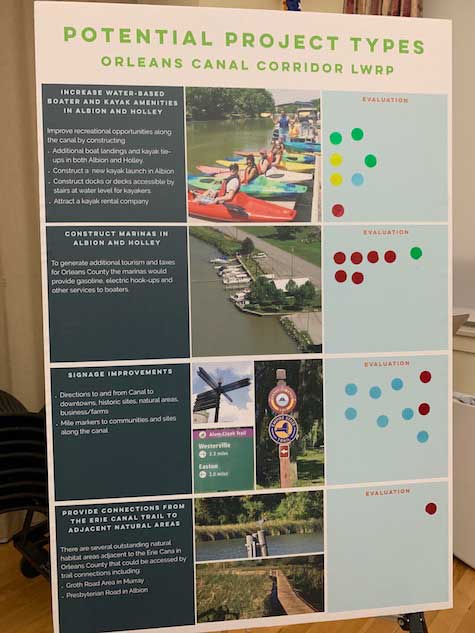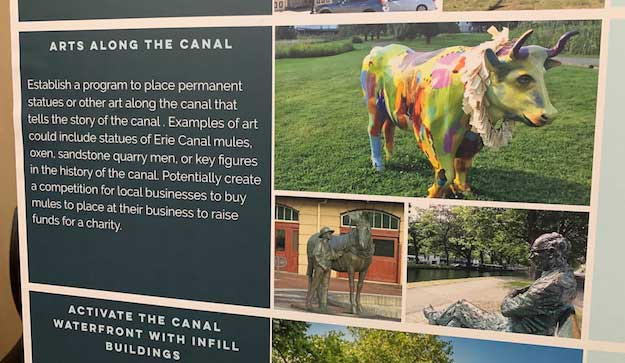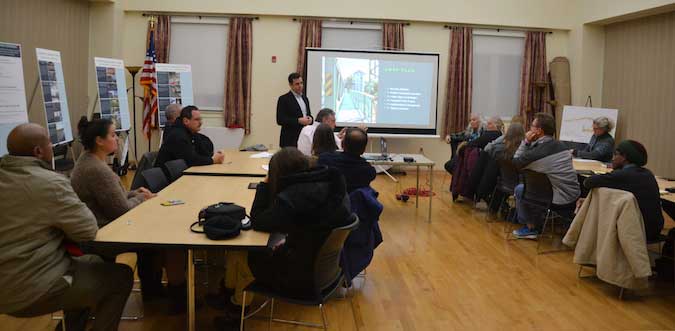Officials say canal plan in Orleans County comes at perfect time
State has many millions available for canal communities with a strategy
ALBION – An effort by several Orleans County municipalities to develop a waterfront plan for better utilizing the Erie Canal couldn’t come at a better time, local officials said.
Gov. Andrew Cuomo is pushing for a $300 million “Reimagine the Erie Canal” program, which is in addition to regular pots of funding from the state for canal projects and other economic development.
The state wants to see a plan for the projects, with assurances the money will be well spent and will make an impact in the canal communities.

Construction of marinas in Albion and Holley were given red stickers, considered a top priority. Community members at a meeting last week also want to see better signage on the canal pointing people to local businesses and attractions. Boaters and kayakers also could use more amenities, such as launches and docks.
“The timing is incredible,” said County Legislator Ken DeRoller, who is a committee member for the Canal Corridor Local Waterfront Revitalization Program Plan. “We’re hitting a sweet spot.”
The committee had a meeting last week at Hoag Library, asking community members to help prioritize projects and areas of focus on the canal.
The county received a state grant for $62,000 to develop the plan and hired LaBella Associates as a consultant for the project. Each municipality along the canal in the county has a representative on the committee, except Medina, which has developed its own plan. The county committee members are representatives from the villages of Albion and Holley, and the towns of Albion, Murray, Gaines, Ridgeway and Shelby.
Ed Flynn, director of planning at LaBella Associates, told the local officials he believes the collaborative approach will stand out when the state considers which projects to give money.
“Orleans County is unique in developing a plan,” he said.
LaBella created poster boards with images and descriptions of potential projects. People at the meeting were given five stickers and asked to put them by projects. They were given two red stickers for highest priority projects, then one each for green (second highest), yellow (third highest) and blue (fourth highest).
LaBella will tabulate the results and give and report during the next meeting, which hasn’t been set.
DeRoller said the lack of a canal waterfront plan has hurt the communities’ chances in getting state grant funding in the past. But that should change now that the canal towns and villages are identifying projects.
“This plan is so imperative to give us leverage,” DeRoller said. “The attractiveness is we’ve never had a plan before so we’ve been kind of left out.”
The plan so far has identified four goals to boost the canal in the county.
Goal 1: Leverage the Canal’s Recreational Resources
(The county and corridor communities should capitalize on the canal’s wealth or land and water-based recreational resources.)
• Attract, develop and grow boating and kayaking facilities
• Provide rental facilities for bikes and kayaks
• Promote year-round sporting competitions to encourage use of recreational opportunities
• Upgrade trail surfaces for bikes
Goal 2: Stimulate Tourism along the Canal

Adding more events would draw visitors and also get local residents more enthused about the canal. Some ideas include launching a barge and bridge festival, where bridges and barge would be closed off for events, such as community dinners, brewfests, wine events, musical performances and food festivals.
(Attraction of local, regional and national visitors will promote the long-term sustainability of the Canal Corridor.)
• Provide full-service marina facilities along the canal
• Increase amenities for boaters and kayakers
• Hold year-round events on and near the canal
Goal 3: Accelerate Revitalization of Corridor Communities
(Investments in villages, downtowns and anchors along the corridor will improve the economy and quality of life for Orleans County residents and benefit businesses and tourists.)
• Provide financing and incentives to targeted businesses that will improve the vitality of village and hamlet centers
• Incubate locally based new businesses along the canal
• Redevelop sites on and near the canal
• Provide financing for agricultural siphoning and facilitate its deployment
• Provide directional and directory signage for businesses in village centers and hamlets
Goal 4: Promote the Corridor’s identity, sense of place and history

Public art projects that feature oxen and mules, two animals critical to the early success of the canal, would promote the canal and could be a fun community project drawing visitors.
(The corridor’s unique character and culture should be promoted, protected and leveraged to advance revitalization of Orleans County and corridor communities)
• Develop branded signage compatible and complaint with canal sign standards for mileposts, history, gateways and directions
• Provide informational signage at key points to tell the corridor’s natural and man-made history
• Revitalize historic and cultural buildings and sites
• Increase access to natural and agricultural areas


























































